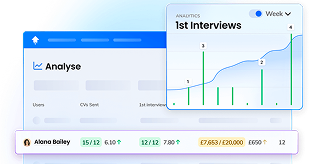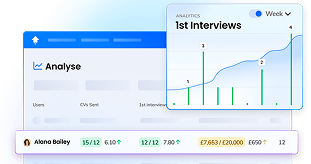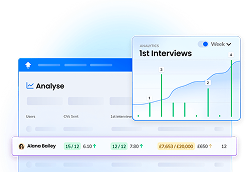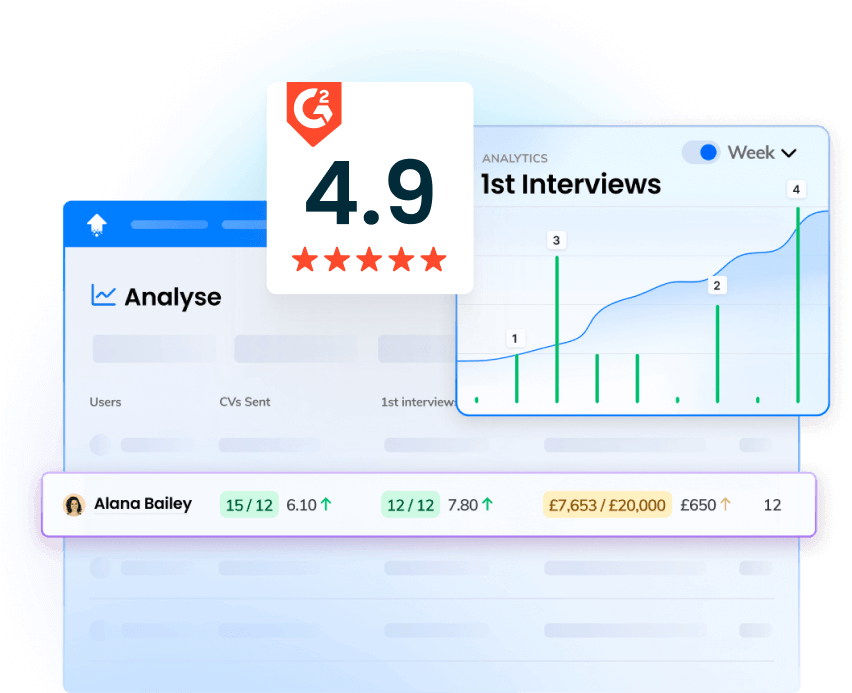In 2025, recruitment agencies and team leads are under greater pressure than ever to demonstrate the impact of their recruitment efforts.
With increasing competition for high-quality candidates, rising hiring costs, and evolving client expectations, agencies that fail to track key metrics risk losing both clients and top talent.
A well-structured recruitment report is no longer just a formality. It is a critical hiring data tool that provides a comprehensive overview of an agency’s recruitment pipeline. It allows recruiting teams to analyse recruiter performance, measure hiring success, and optimise the entire hiring process.
For agencies looking to optimise their recruiting process, secure the best candidates, and improve hiring strategies, recruitment reporting is essential. This guide will provide the valuable insights needed to stay ahead in 2025.
Understanding recruitment reports
A recruitment report provides a structured overview of a recruitment campaign, detailing the candidates recruited, their progress through the recruitment funnel, and the overall hiring success. These reports go beyond simple numbers, offering critical hiring data and context behind recruitment activities, helping team leads and recruitment managers make informed decisions.
For recruitment agencies, these reports are vital tools for assessing candidate quality, tracking recruiter performance, and ensuring that hiring strategies align with client expectations. By measuring key recruitment metrics, agencies can refine their recruitment process, improve the candidate experience, and ultimately achieve better hiring outcomes.
Why Recruitment Reporting Matters for Team Leads
For recruitment team leads, effective reporting plays a crucial role in:
- Improving hiring manager satisfaction by providing clear insights into the recruitment process and ensuring quality of hire.
- Identifying areas for continuous improvement, ensuring that the recruitment strategy remains efficient and adaptable to changing market demands.
- Tracking key recruitment metrics, such as time to hire, candidate quality, diversity metrics, and employee retention rates, to enhance performance.
- Leveraging data to optimise hiring strategies, ensuring a steady pipeline of successful candidates and greater efficiency in filling open positions.
How Recruitment Agencies Use Reporting to Drive Results
Recruitment reports are not just about tracking numbers; they provide a comprehensive overview of an agency’s recruiting efforts, helping teams to:
- Measure the effectiveness of job descriptions, job boards, and other sourcing channels.
- Evaluate how efficiently candidates hired progress through the interview process.
- Identify gaps in the recruitment funnel where candidates may be dropping off.
- Align recruitment efforts with business goals by using recruitment dashboards and pipeline reports.
However, not all reports serve the same purpose — different stakeholders, from recruitment team leads to hiring managers, require varying levels of detail and analysis. While some reports focus on day-to-day recruitment activities, others provide a high-level overview of recruitment pipeline performance and hiring success. Let's explore.
Types of recruitment reports
A recruitment report isn’t a one-size-fits-all document. Instead, different types of reports are designed to address specific recruitment objectives and support team leads, recruitment agencies, and hiring managers in tracking and improving their recruitment efforts.
Here are some of the most common recruitment reporting types:
Recruitment reports for team management
If you’re a recruitment team leader, it’s your job to focus on the granular details of a recruitment campaign. So you need the following types of reports:
- Daily activity tracking: Your daily recruitment report template should incorporate hyper-specific activity targets, such as the number of calls made and CVs sent by individual recruiters.
- Weekly performance tracking: Rather than looking at activity levels, these reports focus on the results of those activities, such as whether your team are hitting their targets for number of interviews booked or candidates placed.
- Monthly performance tracking: Similar to weekly performance tracking reports, but over a longer period.
- Quarterly performance tracking: Again, these reports are similar to the previous two examples, but they typically take a more holistic view and also incorporate business-critical metrics like the amount of revenue generated by placing candidates.
Recruitment reports for senior leadership
Senior leaders are less in the weeds when it comes to the day-to-day business of running a recruitment campaign. Instead, they want to look at monthly, quarterly, and annual recruitment report documents focussing on bigger-picture metrics and trends like:
- Client and candidate pipeline performance
- Comparisons against historical or benchmark data
- Performance against revenue goals
- Percentage of strategic recruitment goals met
- Key learnings to optimise future campaigns
Recruitment reports for recruitment agency clients
Recruitment agency clients want a clear view of how their recruitment project is progressing. These weekly or monthly status reports should incorporate a range of information and data points, such as:
- The current stage of the recruitment project (e.g. sourcing candidates, making offers)
- Actions and deliverables completed since the previous meeting
- Interviews completed to date, plus their outcome
- Break down of ad spending to date
- Plans for spending any remaining ad budget
- Shortlist of top-performing candidates
- Suggestions for changes to the job specification or candidate requirements, if needed
Of course, the longer you spend compiling recruitment reports (internal and external), the less time you have to find their perfect candidate. (This is where a software solution that enables you to build quick and detailed recruitment dashboards could help, *wink*.)
So you should always balance the client’s desire for detail against your own resources and timelines when deciding how much information to include in these reports.
6 key metrics in recruitment reporting
Recruitment reporting is all about focussing on the most relevant recruitment metrics and adding valuable context to explain why you achieved a certain result (and why it matters). With that in mind, let’s take a look at the most important recruitment reporting metrics to cover:
- Jobs added: The number of new jobs an agency wins to recruit for.
- Candidates added: The number of new candidates an agency signs up.
- CVs sent: The number of CVs sent for each job.
- Interviews booked: The number of interviews successfully booked for each job.
- Placements filled: The number of jobs successfully filled.
- Revenue: The amount of revenue won by placing candidates.
If we exclude the “candidates added” metric, we’re left with the five elements of a fairly typical recruitment pipeline. Then the really key area of analysis for understanding performance and efficiency is the ratios between each of those specific metrics (e.g. the ratio of CVs sent to interviews booked).
In other words, while each metric is individually important for reps, and managers would likely set targets for each of these per rep, from a management perspective looking at ratios to try to analyse and improve performance is critical.
5 benefits of effective recruitment reporting
Broadly speaking, a robust recruitment reporting system helps you gauge the effectiveness of specific recruitment activities, which in turn empowers you to make smarter decisions about future strategy. But let’s zoom in on more specific benefits of effective recruitment reporting:
Benefit 1: Identify your top recruiters
Understanding recruiter performance is key to improving recruiting efforts. A well-structured recruitment report allows team leads to measure successful hires, job openings filled, and recruiting funnel efficiency. By identifying top performers, agencies can:
- Replicate the hiring techniques of their best talent professionals.
- Improve training and development programmes to align with best practices.
- Use performance benchmarks to drive hiring manager satisfaction and recruitment ROI.
Benefit 2: Find recruitment process efficiencies
Every recruitment pipeline has bottlenecks - whether it’s slow candidate sourcing, ineffective job boards, or a long interview process. Recruitment analytics helps recruiting teams pinpoint inefficiencies by:
- Tracking time to hire and candidate drop-off rates at different stages of the recruiting funnel.
- Highlighting issues with job descriptions, sourcing channels, or candidate engagement.
- Streamlining the entire hiring process by focusing on successful candidates and eliminating unnecessary steps.
Benefit 3: Drive better results
A data-driven recruitment strategy ensures agencies achieve better hiring outcomes. By analysing recruitment reports, team leads can:
- Optimise recruitment campaigns by focusing on what works.
- Improve recruitment efforts by refining hiring strategies based on pipeline report data.
- Strengthen relationships with clients by demonstrating recruitment ROI and manager satisfaction.
Benefit 4: Know where your best candidates come from
Not all candidate sources are equally effective. A recruitment report template helps agencies analyse where high-quality candidates originate — whether it’s job boards, employee referrals, or direct sourcing. By identifying the most effective recruitment channels, agencies can:
- Reduce recruitment costs by focusing on proven talent sources.
- Improve diversity metrics by identifying gaps in sourcing strategies.
- Increase the quality of hire by prioritising high-performing talent pools.
Benefit 5: Motivate your recruiters
Transparency in recruiter performance metrics helps agencies create a culture of accountability and excellence. By providing access to weekly recruiting reports, pipeline reports, and hiring success data, agencies can:
- Set clear performance benchmarks and reward top recruiters.
- Encourage team collaboration by sharing insights from successful recruitment efforts.
- Foster continuous improvement by helping recruiters identify areas for growth.
How OneUp can help
Creating effective recruitment reporting is all about numbers. If you can’t get the data you need, fast, your reports will never contain the necessary insights or context.
OneUp can help.
Our recruiting analytics software gives you real-time visibility into your performance via customisable dashboards tailored to the metrics that matter to you. And with our workflow automation, reporting no longer requires hours of leg work: you get the reports you need, when you need them.

It’s the perfect tool to streamline your recruitment reporting process.
Closing thoughts
Every recruitment agency has unique reporting needs, shaped by its recruitment strategy, hiring process, and client expectations. However, the biggest challenge across the industry remains the same - gaining full visibility into recruitment performance and transforming raw data into meaningful insights.
Without real-time access to key recruitment metrics, agencies struggle to optimise their recruitment efforts, refine hiring strategies, and measure recruitment ROI. The ability to track, analyse, and visualise performance is what separates high-performing recruiting teams from those relying on guesswork.
This is where OneUp comes in. By automating recruitment reporting, streamlining recruitment analytics, and providing a comprehensive overview of agency performance, OneUp ensures team leads and hiring managers can make data-driven decisions with confidence.
Make recruitment reporting quicker, easier, and more valuable. Request a OneUp demo today to see how data-driven insights can drive your hiring success.




















